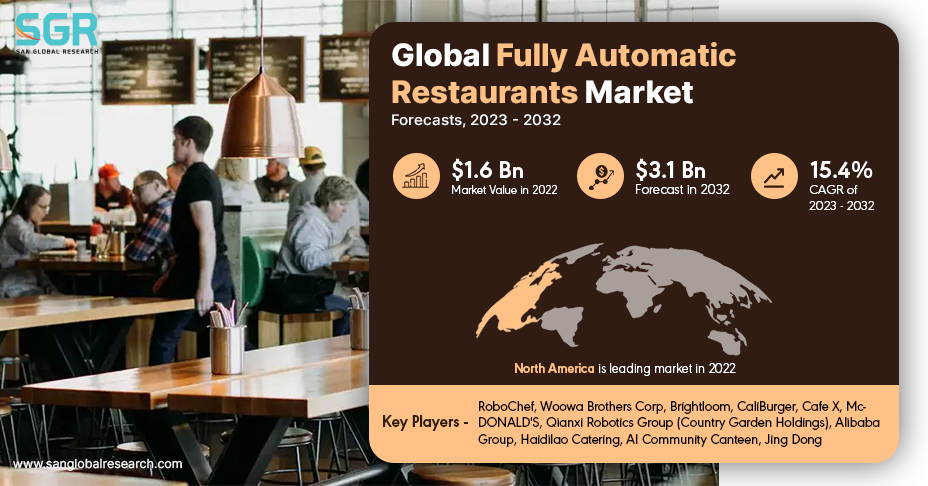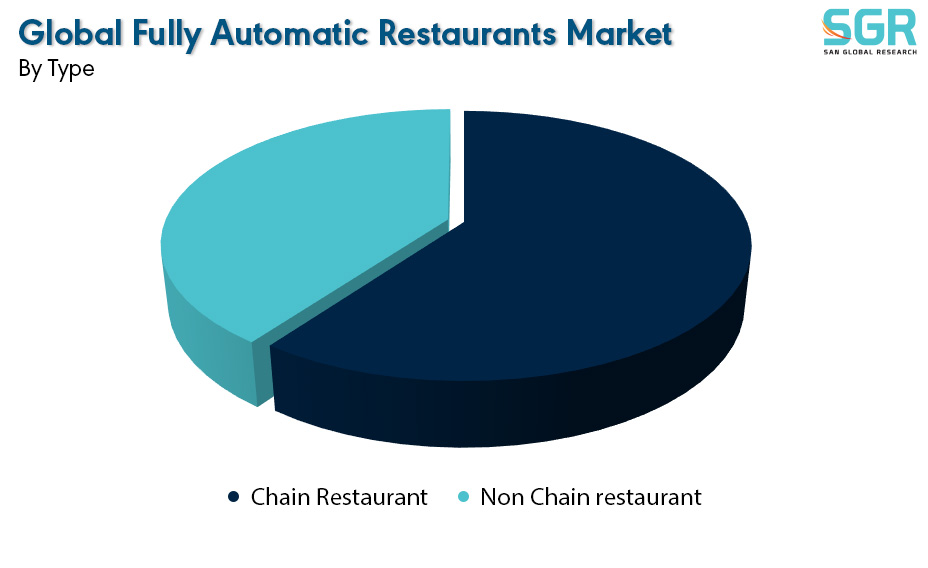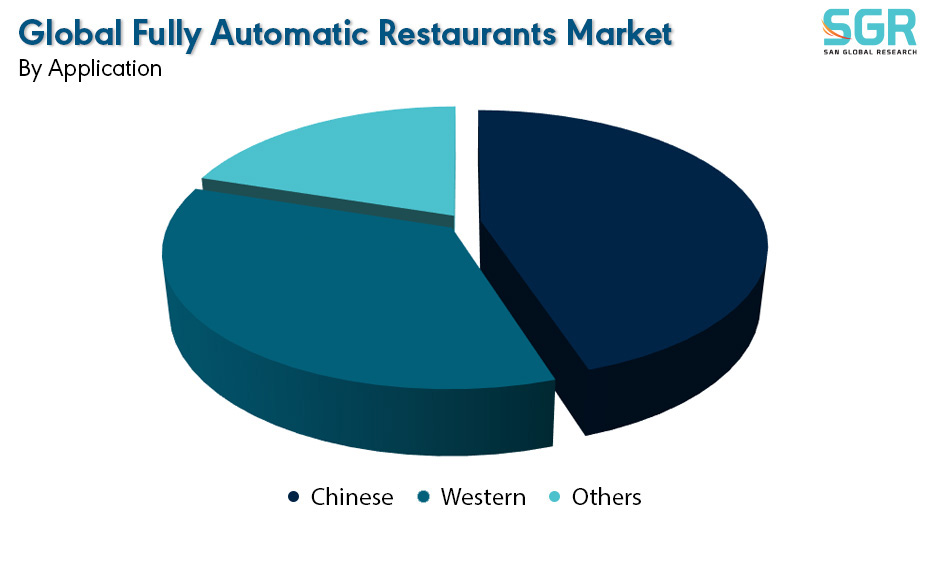Global Fully Automatic Restaurants Market is estimated to be worth USD 1.6 Billion in 2022 and is projected to grow at a CAGR of 15.4% market size of market and the forecast period is 2023 to 2032.

The report analyzes and forecasts the market size, in terms of value (USD Billion), for the market. The report segments the market and forecasts it by Type, by Application and by region/country.
_Bar.jpg)
The global fully automatic restaurants market has witnessed a transformative shift in the dining experience, driven by technological advancements and changing consumer preferences. These automated establishments leverage cutting-edge technologies such as robotics, artificial intelligence, and contactless systems to streamline the entire dining process, from ordering to food preparation and delivery. Customers can place orders through mobile apps, kiosks, or tablets, eliminating the need for traditional waitstaff. Automated kitchen systems ensure precise cooking and timely preparation, enhancing efficiency and reducing human error. The fully automatic restaurants offer a seamless and contactless dining experience, aligning with the growing demand for convenience and hygiene, particularly in the post-pandemic era. The market is characterized by increased customization options, with some establishments allowing customers to personalize their orders through digital interfaces. As technology continues to evolve and consumer acceptance grows, the global fully automatic restaurants market is poised for further expansion, challenging traditional dining models and reshaping the landscape of the food service industry.
.jpg)
Region wise Comparison:
The fully automatic restaurants market in North America has experienced rapid growth, fueled by a tech-savvy consumer base and a robust technological infrastructure. Major metropolitan areas, particularly in the United States, have witnessed the emergence of fully automated dining establishments, leveraging innovations like self-ordering kiosks, robotic chefs, and efficient delivery systems. The market's success is attributed to the region's early adoption of digital trends, with customers appreciating the convenience and speed offered by fully automated restaurants.
Europe has embraced the concept of fully automatic restaurants, with countries like the United Kingdom, Germany, and the Nordic nation’s leading the way. The European market emphasizes the integration of automation to enhance customer experiences and optimize operational efficiency. Stricter hygiene standards, particularly in the wake of the global pandemic, have accelerated the adoption of contactless dining solutions and automated kitchen processes, making fully automatic restaurants a growing trend across the continent.
.jpg)
The Asia Pacific region has become a hotbed for innovation in the fully automatic restaurants market, driven by tech-forward nations such as Japan, China, and South Korea. Here, automated dining establishments not only focus on efficiency but also emphasize the incorporation of robotics and AI for a futuristic and immersive dining experience. The diverse culinary preferences across Asia Pacific nations contribute to a wide array of fully automatic restaurants catering to local tastes and preferences.
Latin America is gradually embracing fully automatic restaurants as the region witnesses a convergence of technological advancements and a burgeoning middle class. Countries like Brazil and Mexico are witnessing the establishment of automated dining outlets that cater to the evolving consumer demands for speed, convenience, and safety. The market growth is also influenced by the region's vibrant food culture, with automated restaurants adapting to local culinary traditions.
In the Middle East, the fully automatic restaurants market is gaining traction, especially in affluent urban centers such as Dubai and Riyadh. The region's interest in luxury and technological sophistication is reflected in the adoption of automated dining solutions. Fully automated restaurants in the Middle East often combine cutting-edge technology with opulent interiors, providing a unique and upscale dining experience for consumers.
While still in its nascent stages, the fully automatic restaurants market in Africa is witnessing slow but steady growth, particularly in urban hubs. Countries like South Africa and Nigeria are seeing the emergence of automated dining establishments, catering to a young and tech-oriented population. The market's expansion is expected to be influenced by a growing middle class and increased awareness of automated dining options.
Australia is experiencing a notable rise in fully automatic restaurants, aligning with the country's tech-savvy populace and penchant for embracing global trends. The Australian market emphasizes both efficiency and sustainability, with automated restaurants incorporating eco-friendly practices and state-of-the-art technologies. The appeal of contactless dining and innovative food service models has contributed to the widespread acceptance of fully automatic restaurants across the continent.
.jpg)
Segmentation:
The Global Fully Automatic Restaurants Market is segmented by Type, by Application and by region/country.
By Type:

Based on the Type, the Global Fully Automatic Restaurants Market is bifurcated into Chain Restaurant & Non Chain restaurant – where Chain Restaurant is dominating and ahead in terms of share.
The global fully automatic restaurants market has witnessed the emergence of chain restaurant types, where multiple outlets adhere to a standardized, automated dining experience. These chains leverage advanced technologies such as self-service kiosks, automated kitchen systems, and robotic chefs to maintain consistency in food quality and operational efficiency across various locations. Chain fully automatic restaurants often offer a seamless customer journey, allowing patrons to place orders, customize meals, and pay through user-friendly interfaces. This model not only capitalizes on the benefits of automation, such as reduced labor costs and increased speed of service, but also establishes a recognizable brand presence in the rapidly evolving automated dining landscape. Chain fully automatic restaurants appeal to consumers seeking a reliable and familiar automated dining experience, contributing to the widespread adoption of this model within the global market.
By Application:

Based on the Application, the Global Fully Automatic Restaurants Market is bifurcated into Chinese, Western & Others – where Chinese is dominating and ahead in terms of share.
On the basis of region
• North America
• Europe
• Asia Pacific
• South America and
• Middle East and Africa
In 2022, North America is anticipated to dominate the Global Fully Automatic Restaurants Market with market revenue of XX USD Million with a registered CAGR of XX%.
Key Players:
The key market players operating in the Global Fully Automatic Restaurants Market include
• RoboChef
• Woowa Brothers Corp
• Brightloom
• CaliBurger
• Cafe X
• McDONALD'S
• Qianxi Robotics Group (Country Garden Holdings)
• Alibaba Group
• Haidilao Catering
• AI Community Canteen
• Jing Dong
Drivers:
Growing sector across the globe
The global fully automatic restaurants market is propelled by a convergence of factors that collectively drive the widespread adoption of automated dining experiences. One of the primary drivers is the increasing demand for efficiency and convenience among consumers, as fully automatic restaurants streamline the entire dining process, from ordering to food preparation and delivery. Technological advancements, particularly in robotics, artificial intelligence, and contactless systems, play a pivotal role in enhancing the operational efficiency of these establishments. The global emphasis on hygiene and safety, accentuated by the challenges posed by the COVID-19 pandemic, has accelerated the adoption of fully automatic restaurants as they minimize human contact in the dining process. Additionally, the appeal of innovative and immersive dining experiences, facilitated by automated technologies, contributes to the market's growth. Rising consumer acceptance of digital interfaces, self-service kiosks, and automated kitchen systems further underscores the drivers propelling the global fully automatic restaurants market, marking a shift in traditional dining paradigms.
Opportunity:
Evolving Market
The global fully automatic restaurants market presents a host of opportunities that extend across technological innovation, enhanced customer experiences, and the potential for sustainable business models. As consumers increasingly prioritize convenience and efficiency, there is a significant opportunity for fully automatic restaurants to capitalize on the demand for streamlined dining experiences. The integration of cutting-edge technologies, such as artificial intelligence and robotics, offers opportunities for continuous innovation in menu customization, order processing, and kitchen automation. Moreover, the growing focus on contactless and hygienic dining experiences, driven by global health concerns, creates a ripe environment for the expansion of fully automatic restaurants. The potential for international expansion and the development of chain restaurant models also presents opportunities for market growth. Additionally, partnerships with food delivery platforms and the incorporation of eco-friendly practices in automated restaurant operations align with sustainability trends, providing a unique opportunity for market differentiation. Overall, the global fully automatic restaurants market offers a dynamic landscape for businesses to thrive by embracing technological advancements and catering to evolving consumer preferences.
| Report Attribute | Details |
| Market Value in 2022 | 1.6 Billion |
| Forecast in 2032 | 3.1 Billion |
| CAGR | CAGR of 15.4% from 2024 to 2032 |
| Base Year of forecast | 2023 |
| Historical | 2019-2022 |
| Units | Revenue in USD Billion and CAGR from 2023 to 2032 |
| Report Coverage | Revenue forecast, Industry outlook, competitive landscape, growth factors, and trends |
| Segments Scope | By Type, By Application |
| Regions Covered | North America, Europe, Asia Pacific, SA and MEA |
| Key Companies profiled | RoboChef, Woowa Brothers Corp, Brightloom, CaliBurger, Cafe X, McDONALD'S, Qianxi Robotics Group (Country Garden Holdings), Alibaba Group, Haidilao Catering, AI Community Canteen, Jing Dong |

 Description
Description
 Table of Content
Table of Content
 Gera Imperium Rise,
Gera Imperium Rise,  +91 9209275355
+91 9209275355


